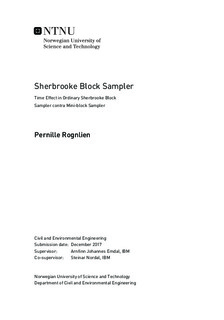| dc.description.abstract | Laboratory work is one of the key factors when gathering information used in geotechnical engineering. It is
therefore of great value to have good quality samples, so that the geotechnical parameters determined are as
representative as possible to avoid overly conservative design. Sampling in sensitive clays is very challenging. It has been shown that sampling with an ordinary tube sampler gives less reliable results when evaluating the soil
conditions compared to results from a block sampler. Sampling using the original Sherbrooke block sampler
requires elevation of the drill rig above ground level, due to the large size of the sampler, and the method is
relatively costly and time consuming. Modifications of the sampler was therefore done by simply downscaling the original sampler to enable sampling at ground level. The difference in sampler size opens the question if the
downscaled sampler, the mini block sampler, retrieves samples of the same quality as the original Sherbrooke
sampler, and if the mini block samples survive storage as well as the original.
To answer these questions, extensive laboratory work was carried out at the geotechnical laboratory at NTNU. Index tests, oedometer and triaxial tests were performed at samples from both mini block and the original Sherbrooke block samplers, retrieved at the NGTS quick clay site at Flotten, Trondheim. An XRD analysis was also done by the Department of Geoscience and Petroleum at NTNU to determine the mineral composition of the soil.
Based on the sample quality criteria and the results from the laboratory investigations it may be concluded that the mini block samples are of the same quality as the Sherbrooke block samples. Results from triaxial tests conclude the same; the peak undrained shear strength su and the strain at failure & ef are the same for both mini block and Sherbrooke block samples. However, oedometer results may conclude the opposite; specimens from the mini block sampler are more disturbed than those from the Sherbrooke block sampler, considering lower values of preconsolidation stress p c, overconsolidation ratio OCR and oedometer modulus for overconsolidated clay MOC. These oedometer results should be treated with caution considering difficulties experienced during testing. Evaluation of the effect of storage shows that mini block samples survives storage just as well as the Sherbrooke block samples based on the sample quality criteria. Regarding the index properties, mini block samples survives almost as well as the Sherbrooke block samples. The main differences before and after storage for the mini block samples are the water content, unit weight and the undrained shear strength su determined from the falling cone test. Almost no change was detected for the oedometer and triaxial tests before and after storage for the mini block samples, except for the triaxial tests from 7 m. | |

